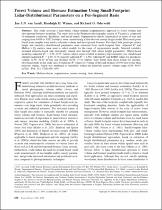 ResearchSpace
ResearchSpace
Forest volume and biomass estimation using small-footprint lidar-distributional parameters on a per-segment basis
JavaScript is disabled for your browser. Some features of this site may not work without it.
- ResearchSpace
- →
- Research Publications/Outputs
- →
- Journal Articles
- →
- View Item
| dc.contributor.author |
Van Aardt, JAN

|
|
| dc.contributor.author |
Wynne, RH

|
|
| dc.contributor.author |
Oderwald, RG

|
|
| dc.date.accessioned | 2007-07-03T06:32:20Z | |
| dc.date.available | 2007-07-03T06:32:20Z | |
| dc.date.issued | 2006-05 | |
| dc.identifier.citation | Van Aardt, JAN, Wynne, RH and Oderwald, RG. 2006. Forest volume and biomass estimation using small-footprint lidar-distributional parameters on a per-segment basis. Forest Science, Vol. 52(6), pp 636-649 | en |
| dc.identifier.issn | 0015-749X | |
| dc.identifier.uri | http://hdl.handle.net/10204/848 | |
| dc.description | Copyright: 2006 Society of American Foresters | en |
| dc.description.abstract | This study assessed a lidar-based, object-oriented (segmentation) approach to forest volume and aboveground biomass modeling. The study area in the Piedmont physiographic region of Virginia is composed of temperate coniferous, deciduous, and mixed stands. Segmentation objects, hierarchical in terms of area and ranging from 0.035 to 5.632 ha/object, were created using a lidar-derived canopy height model. Horizontal point (basal area) samples were used to calculate volume and aboveground biomass. Per-object lidar point (per return height and intensity) distributional parameters were extracted from small-footprint lidar. Adjusted R2 and Mallow’s Cp metrics were used to select models for the range of segmentation results. Selected variables included intensity-based and structurally related first through fifth return height parameters. Object-based modeling (adjusted R2 0.58–0.79; various object sizes) resulted in distinct improvements over stand-based attempts (adjusted R2 0.40–0.73; majority adjusted R2 0.50). Adjusted R2 and RMSE values for deciduous volume (0.59; 51.15 m3/ha) and biomass (0.58; 37.41 Mg/ha) were better than those found for another, plot-based study in the study area. Coniferous R2 values for volume (0.66) and biomass (0.59) were lower than previous studies, which was attributed to variability within the relatively narrow volume range. | en |
| dc.language.iso | en | en |
| dc.publisher | Society of American Foresters | en |
| dc.subject | Remote sensing | en |
| dc.subject | Laser remote measurements | en |
| dc.subject | Multi spectral | en |
| dc.subject | Biomass | en |
| dc.subject | Modelling | en |
| dc.title | Forest volume and biomass estimation using small-footprint lidar-distributional parameters on a per-segment basis | en |
| dc.type | Article | en |
| dc.identifier.apacitation | Van Aardt, J., Wynne, R., & Oderwald, R. (2006). Forest volume and biomass estimation using small-footprint lidar-distributional parameters on a per-segment basis. http://hdl.handle.net/10204/848 | en_ZA |
| dc.identifier.chicagocitation | Van Aardt, JAN, RH Wynne, and RG Oderwald "Forest volume and biomass estimation using small-footprint lidar-distributional parameters on a per-segment basis." (2006) http://hdl.handle.net/10204/848 | en_ZA |
| dc.identifier.vancouvercitation | Van Aardt J, Wynne R, Oderwald R. Forest volume and biomass estimation using small-footprint lidar-distributional parameters on a per-segment basis. 2006; http://hdl.handle.net/10204/848. | en_ZA |
| dc.identifier.ris | TY - Article AU - Van Aardt, JAN AU - Wynne, RH AU - Oderwald, RG AB - This study assessed a lidar-based, object-oriented (segmentation) approach to forest volume and aboveground biomass modeling. The study area in the Piedmont physiographic region of Virginia is composed of temperate coniferous, deciduous, and mixed stands. Segmentation objects, hierarchical in terms of area and ranging from 0.035 to 5.632 ha/object, were created using a lidar-derived canopy height model. Horizontal point (basal area) samples were used to calculate volume and aboveground biomass. Per-object lidar point (per return height and intensity) distributional parameters were extracted from small-footprint lidar. Adjusted R2 and Mallow’s Cp metrics were used to select models for the range of segmentation results. Selected variables included intensity-based and structurally related first through fifth return height parameters. Object-based modeling (adjusted R2 0.58–0.79; various object sizes) resulted in distinct improvements over stand-based attempts (adjusted R2 0.40–0.73; majority adjusted R2 0.50). Adjusted R2 and RMSE values for deciduous volume (0.59; 51.15 m3/ha) and biomass (0.58; 37.41 Mg/ha) were better than those found for another, plot-based study in the study area. Coniferous R2 values for volume (0.66) and biomass (0.59) were lower than previous studies, which was attributed to variability within the relatively narrow volume range. DA - 2006-05 DB - ResearchSpace DP - CSIR KW - Remote sensing KW - Laser remote measurements KW - Multi spectral KW - Biomass KW - Modelling LK - https://researchspace.csir.co.za PY - 2006 SM - 0015-749X T1 - Forest volume and biomass estimation using small-footprint lidar-distributional parameters on a per-segment basis TI - Forest volume and biomass estimation using small-footprint lidar-distributional parameters on a per-segment basis UR - http://hdl.handle.net/10204/848 ER - | en_ZA |





